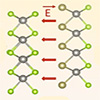| May 16, 2025 |
Researchers identified critical factors in two-dimensional (2D) Janus heterobilayers for green energy conversion.
(Nanowerk News) What if there was an efficient method to produce a viable, environmentally friendly alternative to fossil fuels using the power of sunlight? A significant discovery by researchers at Tohoku University and the University of Science, Vietnam National University – Ho Chi Minh City (VNU-HCM) could bring us one step closer. The team identified critical factors in two-dimensional (2D) Janus heterobilayers for green energy conversion.
|
|
The findings are published in ACS Applied Energy Materials (“Rational Design 2D Heterobilayers Transition-Metal Dichalcogenide and Their Janus for Efficient Water Splitting”).
|
|
Among the investigated materials, a WS₂-SMoSe heterobilayer stood out, with an impressive solar-to-hydrogen conversion efficiency of 16.62%, surpassing many existing materials, most of which have efficiencies below 15%.
|
 |
| Designing 2D Janus heterobilayers for efficient water splitting. The unique Janus structure with an internal electric field enhances photocatalytic performance. The blue arrow indicates that the optimized conditions for water splitting (e.g., carrier mobility, catalyst surface, etc.) can be achieved by rationally designing 2D heterobilayers like LEGO bricks. (Image: Nguyen Tuan Hung et al.)
|
|
Photocatalytic water splitting harnesses sunlight to break down water molecules into hydrogen and oxygen. This clean hydrogen fuel can power vehicles and homes, significantly reducing greenhouse gas emissions and helping to combat global warming. However, traditional materials face substantial challenges in photocatalysis, including low efficiency and rapid electron-hole recombination. This innovation addresses those issues head-on, paving the way for a more sustainable future.
|
|
A team led by Nguyen Tuan Hung, an assistant professor at the Frontier Research Institute for Interdisciplinary Science (FRIS) at Tohoku University, and Vu Thi Hanh Thu, an associate professor at VNU-HCM, has been exploring exciting combinations of Janus and transition-metal dichalcogenide (TMDC) materials.
|
|
They examined 20 different pairings and confirmed that Janus heterobilayers are promising candidates for water splitting. Unlike traditional 2D materials, these unique Janus TMDCs feature different chalcogenide elements on each side, which creates intrinsic dipoles and strong internal electric fields. These natural electric fields enhance the separation of electric charges generated by sunlight, resulting in a significant boost in the photocatalytic performance of these materials. By uncovering the principles of atomic arrangement, we can provide definitive guidance for selecting optimal materials for photocatalytic solar conversion.
|
|
“Combining TMDCs with Janus layers is akin to building with LEGO – there are almost countless configurations to try. Our methodology allows us to efficiently and precisely identify the most promising material combinations for water splitting, dramatically speeding up the discovery process,” asserted first author Nguyen Tran Gia Bao (VNU-HCM).
|
|
“Our findings offer a fresh perspective on sustainable hydrogen production, supporting both environmental protection and energy independence,” stated Nguyen Tuan Hung. “The team is committed to exploring further combinations of materials in future research to discover the most sustainable option out there.”
|


